You have probably seen dozens of t-shirts and sweatshirts recently with a slightly nubbly, heathered texture. This fabric is called slub knit, and it’s becoming a very popular fabric for casual wear. But what is slub knit, and what makes that texture?
Slub knit is a fabric made with yarn that has an uneven texture. The places in the yarn that are thicker than the rest are called “slubs.” In fabric, the slubs make small lumps and create an interesting, irregular texture. The slubs also absorb color differently from the rest of the yarn, heathering the fabric.
You are viewing: What Is A Slub Knit
Slub used to be an undesirable quality that people tried to avoid. Now, it’s growing in popularity, particularly for casual clothing. This guide will take you through the history of slub knit, what to use it for, and how to take care of it.
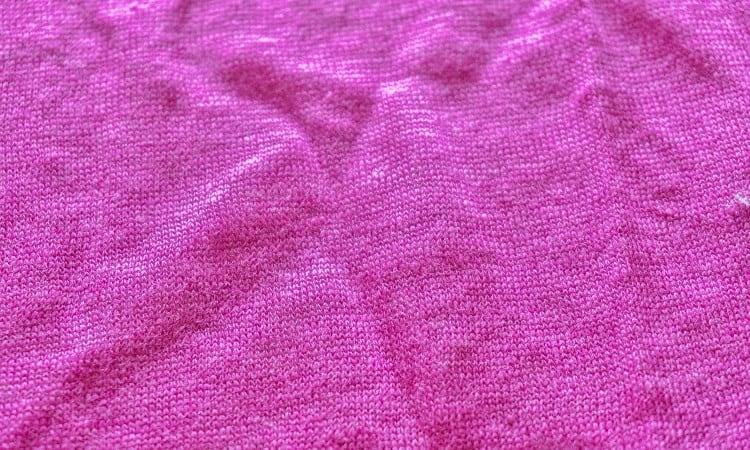
What Is Slub Knit Fabric?
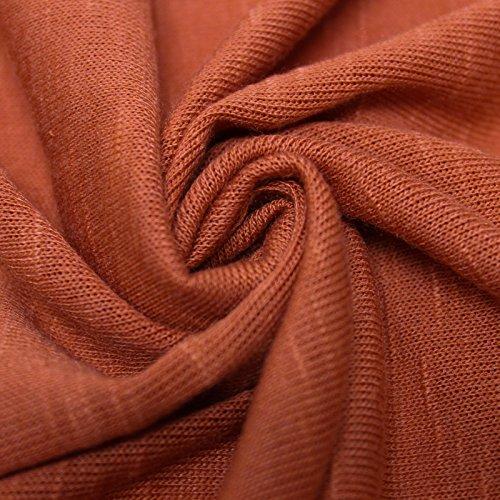 Slub knit fabric is any fabric that’s manufactured with uneven yarn or threads. Before machine spinning, people had to hand-spin fiber into yarn or thread, then knit or weave it into the fabric.
Slub knit fabric is any fabric that’s manufactured with uneven yarn or threads. Before machine spinning, people had to hand-spin fiber into yarn or thread, then knit or weave it into the fabric.
Natural fibers, like cotton or wool, tend to spin unevenly. When spinners got lumps of thicker fiber along the thread they were spinning; the lumps were called slub. The slubs aren’t as tightly twisted as the rest of the thread, making them thicker and softer than the surrounding thread.
Making fabric with slubs in it leads to an uneven texture, with ripples and bumps on the surface. This was a defect, so most spinners picked out the slubs or threw the yarn out.
Machine-spinning helped reduce slub, even in natural fibers. This created the more consistent, uniform fabrics we’re familiar with today. However, this technology also made it possible for manufacturers to create more evenly spaced, intentional slubs.
These intentional slubs create a beautiful visual effect in the final fabric. Slub often takes color differently than the rest of the yarn. Knitting slub into fabric makes a heathered look and texture. You can also use slub for woven fabrics with similar results.
What Is Slub Knit Fabric Made of?
You can find slub fabrics in a wide variety of fibers. However, cotton and cotton blends are the most popular. Natural fibers work well for creating slubs as they are less uniform than man-made threads to begin with, and are easy to manipulate.
It’s also possible to make slubs with filler yarns or lint. The manufacturer can add the extra fibers to the inside of the thread during spinning. This makes it easier to keep the slubs at a uniform distance, so the fabric looks textured rather than messy.
There are slub fabrics other than slub knit, such as silk slub and heavier cotton slub. The heavier the fiber threads are, the harder it is to get a uniform fabric. Manufacturers weave with the thicker yarns to maintain better control of the finished fabric.
What Are the Characteristics of Slub Knit Fabric?
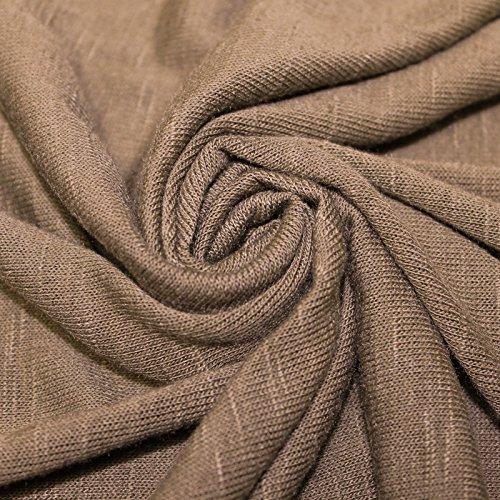 Slub knit fabric is a stretchy fabric that is generally next-to-skin soft. There are different weights of slub knit, so you can have thick terry cloth or thinner t-shirt cotton that both have slubs. No matter the weight, slub knit fabric has most of the same characteristics as other knits.
Slub knit fabric is a stretchy fabric that is generally next-to-skin soft. There are different weights of slub knit, so you can have thick terry cloth or thinner t-shirt cotton that both have slubs. No matter the weight, slub knit fabric has most of the same characteristics as other knits.
The structure of the fabric makes it stretchy without losing structure. The stretchier the original fiber, the stretchier the final fabric will be. Fibers with more give, like cotton, will make a stretchier knit than a cotton/acrylic blend.
The weight of the threads and how tightly the machine knits them together determines how see-through the fabric will be, as does the color. The slub portions of the fabric are also usually less color-saturated than the rest of the fabric.
Read more : What Is 3.5 Of 600 000
The final look and feel also depend on the knit technique the manufacturer uses. You can have a slub knit with interlock, jersey, sweatshirt fleece, or French terry stitch patterns. The unifying characteristic is the lumpy texture that the slubs create.
Is Slub Knit Fabric Always Cotton?
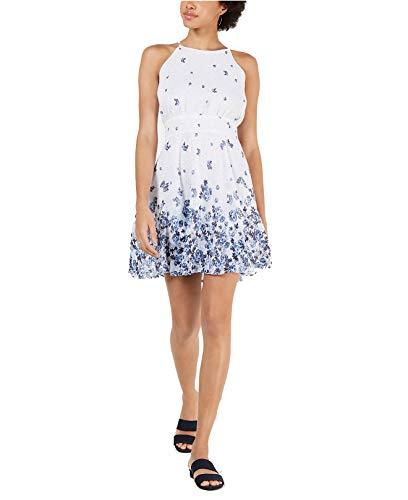 While cotton slub knit t-shirts and sweatshirts are popular, not all slub is cotton. Making slub thread or yarn is more expensive than making even-thickness yarn. One way manufacturers keep the cost of slub knit fabric down is to use a cotton blend.
While cotton slub knit t-shirts and sweatshirts are popular, not all slub is cotton. Making slub thread or yarn is more expensive than making even-thickness yarn. One way manufacturers keep the cost of slub knit fabric down is to use a cotton blend.
Polyester, elastane, and other man-made fibers are frequently present in slub knit fabric alongside cotton. For heavier garments and even some upholstery, there’s slub knit fabric made of wool.
Woven fabrics with slub texture come in a wider variety of fiber types. Silk, linen, and wool are all common fibers in woven slub fabrics. Tweed and twill are examples of woven slub wool. Shantung, Thai silk, and silk noil are all examples of woven slubs made of silk fibers.
Woven cotton slub fabric also exists. However, it’s rare to see knitted fabrics made with silk, linen, or wool. These fibers tend to make thicker threads than cotton and cotton blends, which makes them easier to weave with.
What Is Slub Jersey Knit Fabric?
Slub jersey knit fabric describes both what the fabric is made out of (slub) and how it was made (Jersey knit). This particular slub is usually made with cotton fibers or a cotton blend.
Jersey is a style of knitting. It originated on the British island, Jersey, when the island was a major textile exporter in medieval times. Coco Chanel made the fabric more famous in the early 20th century by using it for garments other than underwear.
It’s a single-yarn knit where all the loops face the same direction. The interlocking loops have stretch in all directions, though primarily horizontally. It’s one of the most common fabric knitting techniques today. You can find it in t-shirts, sweatshirts, underwear, sheets, pajamas, dresses, and sweat pants.
Jersey has a right side and a wrong side. The wrong side is flat loops, whereas the front is tiny vertical rows of v-shaped stitches. It’s easier to tell with slub than other knit jersey fabric than plain jersey as the slubs tend to sit more forward on the right side.
Does Slub Knit Fabric Shrink?
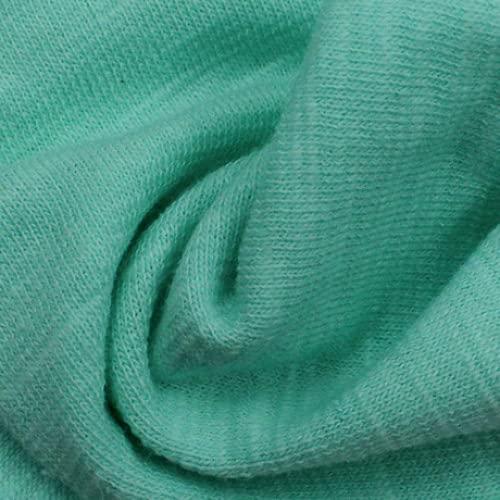 Slub knit fabric can shrink, especially if it is made of 100% cotton. Pure cotton will shrink if you dry it on high heat, especially if it isn’t pre-shrunk. Check the fabric label carefully. It will tell you what temperature is safe for your garment.
Slub knit fabric can shrink, especially if it is made of 100% cotton. Pure cotton will shrink if you dry it on high heat, especially if it isn’t pre-shrunk. Check the fabric label carefully. It will tell you what temperature is safe for your garment.
The best way to keep slub knit fabric from shrinking is to air dry it. This also helps the fabric last longer and maintain its stretch. You don’t have to hang-dry slub knit fabrics immediately after washing. You can put them through a brief tumble dry session on low heat.
Take the fabric out of the dryer while it is still slightly damp, and let it air dry the rest of the way. The air circulation will help keep it from shrinking. If you accidentally shrink a slub knit, you can get it wet and gently stretch it back into shape.
If your slub knit fabric isn’t 100% cotton, it could still shrink in the wash. However, it is less likely to shrink if it’s polyester or another man-made fiber and if you carefully follow the care instructions on the tag. Using a gentle cycle or delicate laundry detergent will also help the fabric stay vibrant for longer.
Is Slub Knit Stretchy?
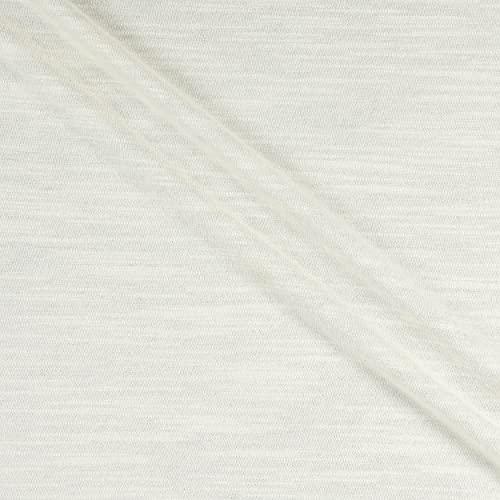 Slub knit is a stretchy fabric, particularly when it’s a jersey knit style slub. The slubs don’t change the stretch of the fabric much. They aren’t twisted as tightly as the rest of the threads in the fabric, so they won’t expand quite as much.
Slub knit is a stretchy fabric, particularly when it’s a jersey knit style slub. The slubs don’t change the stretch of the fabric much. They aren’t twisted as tightly as the rest of the threads in the fabric, so they won’t expand quite as much.
However, knit-style fabrics are inherently stretchy because of the construction of the fabric. The parallel stitching lines have a lot of horizontal stretch, and the vertical rows have a moderate amount of stretch.
Single-knit slub jersey fabric is the stretchiest manufacturing style of slub fabric. Cotton blends with a stretchy fiber like elastane can make slub knit very stretchy without the garment losing shape.
Read more : What Color Profile Should I Use On Mac
A slub knit fabric will also be stretchier than a woven slub fabric. There’s more give in knit fabric because all the threads and loops face the same direction. In a weave, the tension between the threads going vertically and the threads going horizontally minimizes the stretch.
If you want a less stretchy slub knit, look for a double-knit fabric. Double-knit fabrics are two panels of single knitting held together, so they interlock. Sometimes called interlock knit fabric, this thicker fabric has less give than single-knit fabric and holds its shape a little better.
What Is Slub Knit Fabric Used for?
The most common slub knit item is a plain t-shirt. When you see a t-shirt with a heathered or marled finish, take a closer look at the fabric. The bumps and ridges come from the slubs in the threads, adding dimension and interest to the fabric.
Slub knit fabric is also popular for sweatshirts and other casual clothing. T-shirt dresses, sweatpants, and pajamas are other examples of garments taking advantage of the slub knit fabric trend. It’s less common on household textiles (like blankets and towels) and more formal garments.
Sturdier slub fabrics are usually woven, not knit. Outerwear and upholstery are common objects that get the slub treatment, but not with knit fabric. You don’t want a stretchy tweed overcoat or a sofa cushion that will lose its shape quickly.
Slub silk fabrics are most common in formal wear. Shantung silk is a slub textured woven fabric that has a high-quality sheen and holds shape well. It’s a good choice for adding subtle visual interest to a gown or other formal garment.
How to Care for Slub Knit Fabric
The best way to take care of slub knit fabric is to treat it with the same care you would give the pickiest fiber that it has. For example, if you have a cotton/elastane blend, you should launder it like it was entirely elastane, avoiding high heat and excessive stretching.
For the popular slub knit cotton t-shirt, you should wash it in lukewarm water using a gentle cycle and a delicate laundry detergent. Dry it in a low-temperature tumble cycle, but take it out when it’s still damp and let it air dry the rest of the way.
Slub knit fabric is not wrinkle-prone, so you shouldn’t need to iron it regularly. Ironing slub knit could flatten the slubs and ruin the texture, so you should only iron slub knit fabric with a press cloth and low heat. Generally, folding a slub knit garment and storing it in a cool, dry place, like a dresser, will keep it in good condition.
Like most knit fabrics, slub knit is prone to stretching out of shape as it ages. Air drying will slow this process down. However, if you tumble dry slub knit fabric frequently, it could not only stretch it out but also degrade the fabric, making it more prone to holes faster.
What Is Slub Knit Yarn?
Slub isn’t just for fabric and garments! The same spinning technique that makes the super-fine threads for commercial machine-knitting can make slub yarn for hand-knitting. Just like in slub knit fabric, slub yarn gives your finished project additional texture and interest.
The best stitches for slub yarn are simple, repetitive stitches that let the slubs stand out. Seed or moss stitch, stockinette, and ribbing are all good choices for a slub yarn. However, keep in mind that you’ll need to adjust your tension as you go.
The parts of the yarn with slubs will make thicker stitches than the rest of the yarn. If you don’t loosen your tension for the thinner stitches, your rows won’t be even and your finished project will be uneven. The larger the slubs are, the more you’ll have to adjust.
Using slub knit yarn is a great way to get the stretch and movement of a slub knit fabric with the look of a tweedy woven slub. Slub yarn is an easy way to add a touch of sophistication to your work without adding much extra effort.
Conclusion
Slub knit fabric is proof that sometimes, mistakes do pay off by taking a spinning defect and turning it into a fashion trend. Instead of throwing it away, textile manufacturers now sell slub knit fabric all over the world.
Are you planning on using slub knit fabric for your next project? Leave us a comment to let us know what you would make with it!
Source: https://t-tees.com
Category: WHAT
